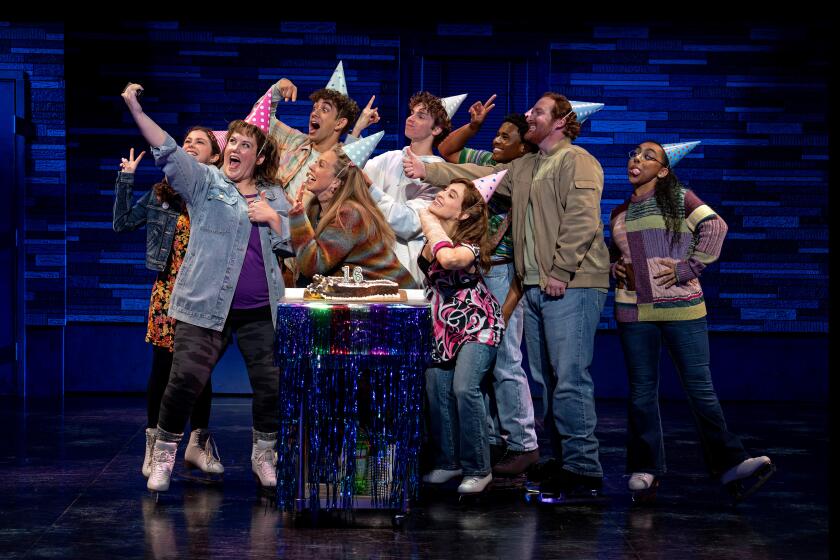ART REVIEW : HONDA ART SHOWING IS MAGICAL
The works by Margaret Honda at the Anuska Galerie (2400 Kettner Blvd.) are presented in one of the most sophisticated and strangely beautiful installations that I have seen in San Diego.
The artist’s sculptural forms are referentially utilitarian but used for their abstract beauty and metaphorical suggestiveness.
Both the material and forms Honda uses are threatening: Barbed-wire is shaped to simulate parts of armor such as the shields and thigh and shin guards you might see in a Kurosawa epic. The paradox that what is protective is also dangerous is indicative of the metaphorical richness of these ostensibly simple pieces.
Only one of the sculptures, “Boots” (1986), is floor-oriented, as it should be. The form is as contemporary as GI issue. All the other sculptures seem to float in the space at heights appropriate for their functions--a cuirass at chest level, a helmet at head level. Their nature dictates the human scale of the exhibition.
What they represent is easily perceived, although they resemble three-dimensional sketches more closely than plastic forms because of the linear character of barbed-wire. It is precisely this quality that is responsible for much of the magic of the exhibition. The floor-level illumination projects much-enlarged shadows of the intricately composed vertical and horizontal wires in curving planes onto the walls, where they look like patterns of scumbled lines. The experience of seeing these shadows and the barbed objects reminds us that formal qualities and even ideas are often things of beauty until expressed in material form.
Honda had the help of artist Brent Riggs in creating the installation, which is reminiscent of an exhibition of works, abstract body parts in steel and concrete, by gifted Los Angeles artist Peter Shelton at the L.A. Louver Gallery in Venice about 18 months ago.
It is even more closely related to the spectacular exhibition of works by Japanese fashion designer Issey Miyake at the San Francisco Museum of Modern Art two years ago. Miyake also has made works, albeit items of high fashion, inspired by ancient Japanese armor.
Honda, like Miyake, has fashion in her background. Last year in “A San Diego Exhibition: Forty-Two Emerging Artists” at the La Jolla Museum of Contemporary Art, she showed garments that for all their minimalism were nevertheless charged with erotic grace. Her present works could scarcely be more radically different, and yet their metaphorical content is humanistic.
Barbed-wire is an American invention of great significance in U.S. economic, social, military and penal history. The title of Honda’s exhibition, “Incident at DeKalb,” refers to the county fair in De Kalb, Ill., where the prototype for barbed-wire was displayed in 1873.
The funereal black and white combination of the exhibition’s announcement evinces Honda’s awareness of barbed-wire’s somber history--its role in range warfare between cattlemen and farmers, its use in trench warfare, in riot control, in prisons and in internment camps. On the other hand, barbed-wire also protects people and property. Margaret Honda has made art out of it. It’s a banal material but evocative, painfully so.
Drawing on two cultures, Honda, along with other significant artists of Japanese ancestry such as the Yonemoto brothers in video art, Mineko Grimmer in sculpture and David Izu in painting, not to forget Isamu Noguchi in everything, is contributing a significant Japanese component to the cultural heritage of all civilized Californians.
The exhibition has been extended through March 29.
More to Read
The biggest entertainment stories
Get our big stories about Hollywood, film, television, music, arts, culture and more right in your inbox as soon as they publish.
You may occasionally receive promotional content from the Los Angeles Times.










